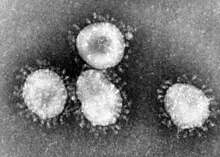SARS-CoV
| Coronavirus | |
|---|---|
 |
|
| Virus classification | |
| Group: | Group IV ((+)ssRNA) |
| Order: | Nidovirales |
| Family: | Coronaviridae |
| Subfamily: | Coronavirinae |
| Genus: | Betacoronavirus |
| Species: | SARS coronavirus |
The SARS coronavirus, sometimes shortened to SARS-CoV, is the virus that causes severe acute respiratory syndrome (SARS). On April 16, 2003, following the outbreak of SARS in Asia and secondary cases elsewhere in the world, the World Health Organization (WHO) issued a press release stating that the coronavirus identified by a number of laboratories was the official cause of SARS. Samples of the virus are being held in laboratories in New York City, San Francisco, Manila, Hong Kong, and Toronto.
On April 12, 2003, scientists working at the Michael Smith Genome Sciences Centre in Vancouver, British Columbia finished mapping the genetic sequence of a coronavirus believed to be linked to SARS. The team was led by Dr. Marco Marra and worked in collaboration with the British Columbia Centre for Disease Control and the National Microbiology Laboratory in Winnipeg, Manitoba, using samples from infected patients in Toronto. The map, hailed by the WHO as an important step forward in fighting SARS, is shared with scientists worldwide via the GSC website (see below). Dr. Donald Low of Mount Sinai Hospital in Toronto described the discovery as having been made with "unprecedented speed". The sequence of the SARS coronavirus has since been confirmed by other independent groups.
The SARS coronavirus is one of several viruses identified by WHO as a likely cause of a future epidemic in a new plan developed after the Ebola epidemic for urgent research and development before and during an epidemic toward new diagnostic tests, vaccines and medicines.
...
Wikipedia
